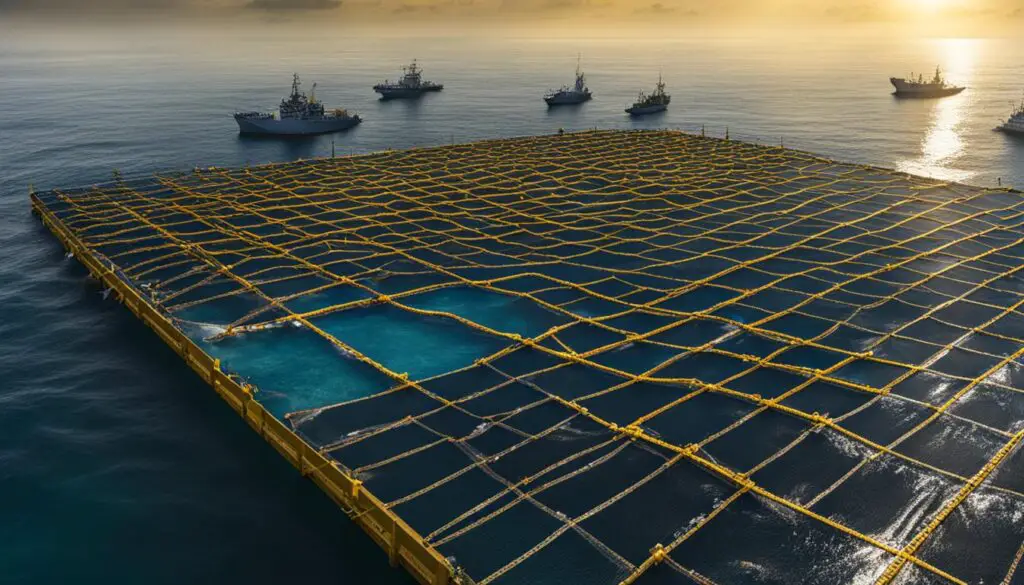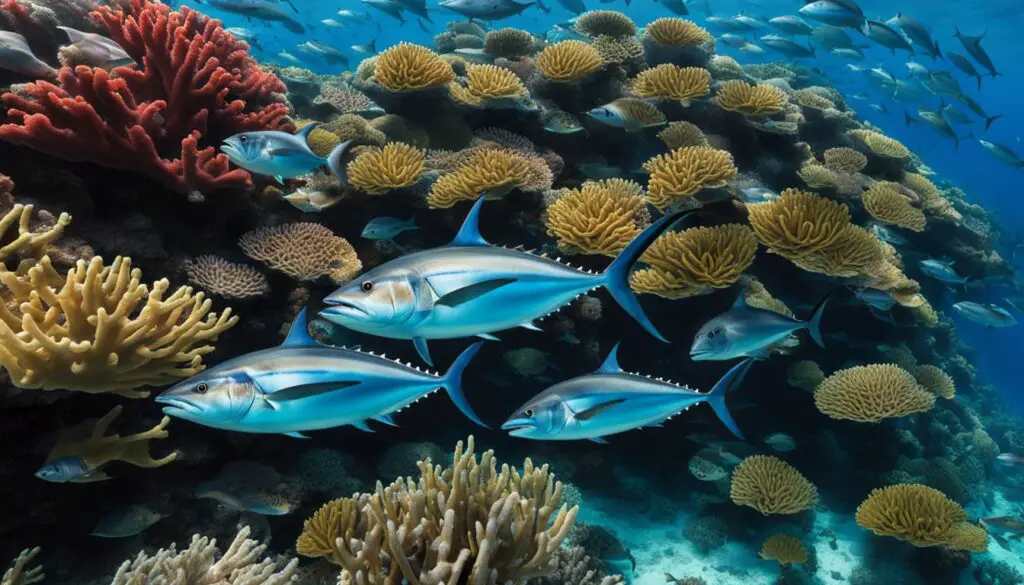Have you ever wondered how long tuna can live? Join us as we dive into the fascinating world of tuna lifespan and uncover the secrets behind their longevity. From the average tuna lifespan to the factors that affect their longevity, we’ll explore it all to give you a better understanding of these magnificent creatures.
Key Takeaways:
- Tuna lifespan varies depending on the species and environmental factors.
- Pacific bluefin tuna can live up to 30 years in the wild.
- Yellowfin tuna typically have a lifespan of 6 to 9 years.
- Tuna in captivity may have shorter lifespans due to confinement and stressful conditions.
- Conservation efforts and sustainable fishing practices are crucial for the long-term survival of tuna species.
Factors Affecting Tuna Lifespan
Tuna lifespan in the wild can be influenced by several factors. The most significant factor is the habitat and environmental conditions in which they live. Tuna species are well-adapted to thrive in temperate and tropical waters, where they have access to abundant food sources. The availability of prey plays a crucial role in their overall health and lifespan. Additionally, predation and fishing pressure can significantly impact the lifespan of tuna. Overfishing, in particular, can lead to the depletion of tuna populations, reducing their ability to reproduce and survive.
Another factor that can affect tuna lifespan is their captivity conditions. Tuna that are caught and kept in confinement for aquaculture purposes may have shorter lifespans due to the stress of captivity and the conditions in which they are raised. These factors can impact their overall well-being and lifespan. It is essential to consider both the natural habitat and captive conditions when assessing the lifespan of tuna.
Understanding the factors that affect tuna lifespan is crucial for their conservation and management. By addressing issues such as overfishing, habitat destruction, and improving aquaculture practices, we can work towards ensuring the long-term survival of tuna species and maintaining healthy populations in the wild.
Lifespan of Different Tuna Species
When it comes to the lifespan of tuna, different species exhibit varying lifespans. Pacific bluefin tuna, for example, can live up to 30 years in the wild, with some individuals reaching 20 to 25 years. This majestic species is known for its impressive size and endurance, and its relatively long lifespan contributes to its resilience in the wild. On the other hand, yellowfin tuna have a shorter lifespan, typically ranging from 6 to 9 years. Other species, such as bigeye tuna and skipjack tuna, also have lifespans that fall within similar ranges.
While these average lifespans provide a general idea, it’s important to note that the exact lifespan of each tuna species can be influenced by various factors. Habitat, predation, and fishing pressure are just a few examples of the variables that can impact the lifespan of these magnificent creatures. It’s also worth mentioning that individual tuna within a species can exhibit slight variations in lifespan due to factors such as genetics, diet, and overall health.
Why the lifespan of different tuna species matters
The lifespan of different tuna species is an important consideration for scientists, conservationists, and fisheries managers. Understanding the natural lifespan of tuna can help inform conservation efforts and sustainable fishing practices. It also offers insights into the overall health of tuna populations and can assist in evaluating the impact of human activities on these species.
“The lifespan of different tuna species is an important aspect of their ecology and biology. It provides valuable information for fisheries management and conservation efforts, allowing us to make informed decisions to protect these remarkable creatures and the delicate ecosystems they inhabit.” – Dr. Marine Biologist
By studying the lifespans of various tuna species, scientists can gain a deeper understanding of their life history, reproductive patterns, and vulnerability to environmental and anthropogenic pressures. This knowledge serves as a foundation for developing effective management strategies that ensure the long-term sustainability of tuna populations for future generations.

Methods to Determine Tuna Age
Tuna lifespan is a subject of significant interest to researchers, and determining their age is a crucial part of understanding their life history. There are several methods used to determine the age of tuna, with one of the most common being the examination of otoliths, also known as “ear bones.”
Otoliths are small, oval bones located in the inner ear of fish. They grow continuously throughout a tuna’s life, forming distinct annual growth rings, similar to the rings found in tree trunks. By counting these rings, scientists can estimate the age of a tuna and study its growth rate over time. The examination of otoliths provides valuable insights into the age structure and population dynamics of tuna species.
“The examination of otoliths is a widely recognized and accurate method for determining the age of fish species, including tuna. These tiny bones serve as natural recorders of a fish’s growth, providing a wealth of information about its life history.” – Dr. Jane Davis, Marine Biologist
In addition to otoliths, other parts of the fish, such as scales, bones, and fin rays, can also be used to estimate the age of tuna. However, the examination of otoliths remains the most reliable and widely used method. It provides detailed information about the age structure of tuna populations, which is vital for effective fisheries management and conservation efforts.
Tuna Feeding and Growth Patterns
Tuna are remarkable predators with a diverse diet that includes small fish, squid, eels, and crustaceans. They prefer energetically rich fish, such as anchovies, sardines, herring, and mackerel, which provide them with the necessary nutrients for their rapid growth. In their early years, tuna experience a rapid growth rate, with most of their growth occurring before the age of five. However, as they age, the growth rate slows down.
Several factors can influence the feeding and growth patterns of tuna. One of the key factors is food availability. Tuna thrive in areas where there is an abundant supply of their preferred prey. Temperature also plays a role, as tuna are ectothermic and their metabolic processes are influenced by the surrounding water temperature. Additionally, the overall health and condition of the tuna can impact their growth rate.

Fun Fact: Did you know that tuna are one of the fastest swimmers in the ocean, capable of swimming at speeds of up to 75 kilometers per hour?
Feeding Habits
Tuna are known for their highly efficient feeding habits. They have evolved to be powerful and fast swimmers, enabling them to chase down their prey. Tuna often feed in schools, taking advantage of the collective hunting strategy to increase their chances of capturing prey. Their sharp teeth and streamlined bodies allow them to swiftly catch and devour their food.
Growth Rate
Tuna’s growth rate varies among different species and is influenced by several factors. While they experience rapid growth in their early years, their growth rate gradually slows down as they reach maturity. The exact growth rate and size of tuna can vary depending on the species, environmental conditions, and availability of food.
“Tuna are designed for speed, enabling them to cover vast distances in search of food. Their feeding and growth patterns are synchronized with their ability to swim long distances and hunt efficiently.”
Tuna’s feeding and growth patterns are intricately linked to their physiology and the resources available to them. Understanding these patterns is crucial for effective management and conservation efforts to ensure the longevity and sustainability of tuna populations.
Tuna Migration and Behavior: Exploring their Migratory Patterns and Fascinating Behavior
Migration is a fundamental aspect of tuna’s lives, as these remarkable fish exhibit extensive horizontal and vertical movements, covering vast distances across entire ocean basins. Tuna migrate in search of food, suitable breeding grounds, and optimal environmental conditions. This migratory behavior allows them to access abundant food sources and escape unfavorable conditions, ensuring their survival and reproductive success.
Tuna often form feeding aggregations during non-spawning seasons, where individuals come together to exploit dense schools of prey. These aggregations are not limited to a single species but are based on size, with tuna of similar sizes swimming together. This schooling behavior provides various benefits, including increased foraging efficiency, protection from predators, and improved communication.
Tuna are fascinating creatures with well-developed sensory systems that enable them to perceive their environment and communicate with one another. Their sensory capabilities include exceptional vision, acute touch sensitivity, and the ability to detect chemical cues in the water. These sensory adaptations play a vital role in their predatory behavior and their ability to navigate through vast oceanic habitats.
The Complexity of Tuna Migration
Tuna migration is a complex phenomenon influenced by various factors, including water temperature, ocean currents, and the availability of food. Some tuna species, such as the Pacific bluefin tuna, undertake long-distance migrations, traversing thousands of miles between their feeding and spawning grounds. These migratory routes often follow predictable patterns, allowing researchers to study and track the movements of these elusive fish.
Understanding the intricacies of tuna migration is crucial for effective conservation and management efforts. By unraveling the mysteries of their migratory patterns and behavior, scientists can gain insights into the impact of human activities, such as overfishing and habitat destruction, on these magnificent creatures. Conservation measures aimed at protecting critical migration routes and ensuring the availability of suitable habitats can go a long way in safeguarding the future of tuna and preserving their natural behavior.
Threats to Tuna Lifespan
Tuna species face numerous threats that can significantly impact their lifespan. One of the major concerns is overfishing, which has led to the decline of tuna populations worldwide. The demand for tuna as a food source has put immense pressure on their numbers, leading to unsustainable fishing practices and the depletion of tuna stocks. Overfishing not only reduces the overall population size but also disrupts the reproductive capabilities of tuna, hindering their ability to replenish their numbers.
Another threat to tuna lifespan is habitat destruction. Pollution, climate change, and ocean acidification are all contributing factors that can harm the ecosystems where tuna thrive. These environmental changes can disrupt the availability of food sources and alter the migratory patterns of tuna, impacting their ability to find suitable breeding and feeding grounds. Additionally, the destruction of critical habitats such as coral reefs and seagrass beds can further threaten the survival of tuna species.
“The overfishing of tuna poses a significant risk to their lifespan. The demand for tuna as a food source, particularly for sushi and sashimi, has resulted in extensive fishing efforts that often exceed the sustainable limits of the populations. As a result, tuna populations have been heavily depleted, and their ability to survive and reproduce has been severely compromised. Overfishing not only impacts the target tuna species but also has cascading effects on the entire marine ecosystem.”
Climate change is also a significant threat to tuna lifespan. Rising ocean temperatures and increased acidity levels affect the distribution and availability of food sources for tuna. These changes can disrupt the delicate balance of their marine environment, making it difficult for tuna to find sufficient nourishment. Furthermore, climate change can alter ocean currents and temperature gradients, potentially displacing tuna from their preferred habitats and forcing them to migrate to unfamiliar areas where survival may be challenging.
To protect tuna populations and ensure their long-term survival, conservation efforts and sustainable fishing practices are crucial. These include implementing strict fishing regulations, such as catch limits and size restrictions, to prevent overfishing. Creating marine protected areas and implementing sustainable fishing techniques that minimize bycatch and habitat damage are also essential steps in safeguarding tuna populations.
Tuna Farming and Aquaculture
Tuna farming, also known as aquaculture, is an important practice in today’s seafood industry. It involves the cultivation of tuna in controlled environments to meet the growing demand for this popular fish. While tuna farming has its benefits, including a steady supply of fish and reduced pressure on wild populations, it also raises concerns about the lifespan of farmed tuna compared to their wild counterparts.
When tuna are raised in captivity, they may experience higher levels of stress due to confinement and less natural conditions. This can potentially impact their overall lifespan. Additionally, the quality of their diet, water conditions, and other factors in aquaculture systems can affect the growth and health of farmed tuna.
Studies have shown that farmed tuna may have shorter lifespans compared to tuna in the wild. The stress of confinement and suboptimal conditions can contribute to various health issues and reduce the overall longevity of farmed tuna (FAO, 2019).
Efforts are being made within the aquaculture industry to improve the conditions in which tuna are raised. This includes advancements in technology, such as larger and more naturalistic tank systems, improved nutrition, and better disease management practices. By prioritizing the welfare and well-being of farmed tuna, it is possible to mitigate some of the factors that can negatively impact their lifespan.

Sources:
- FAO (2019). The State of World Fisheries and Aquaculture 2018—Meeting the sustainable development goals. Retrieved from [link]
Management and Conservation Efforts
Tuna species, including Pacific bluefin tuna, are managed by regional fisheries management organizations (RFMOs) that aim to implement conservation and management measures to protect tuna populations. These measures include catch limits, size restrictions, and seasonal closures to reduce overfishing and ensure the sustainable management of tuna stocks. The goal is to maintain healthy ecosystems and balance the needs of fishing communities with the long-term sustainability of tuna species.
One of the key conservation measures is the implementation of catch limits, which set a maximum number of tuna that can be caught within a specific time period. This helps prevent overfishing and allows tuna populations to replenish and grow. RFMOs also enforce size restrictions, which ensure that smaller, juvenile tuna have a chance to mature and reproduce before being caught. By protecting the younger generation, the future of tuna populations is safeguarded.
Seasonal closures are another important conservation measure. These closures restrict fishing activities during specific periods or in certain areas to protect spawning grounds and allow tuna to reproduce without disturbance. By giving tuna a safe environment to breed and replenish their populations, these closures aid in the long-term sustainability of tuna species.
Tuna conservation measures include:
- Implementing catch limits to prevent overfishing
- Enforcing size restrictions to protect juvenile tuna
- Implementing seasonal closures to protect spawning grounds
- Improving monitoring and data collection to better understand tuna populations
- Encouraging sustainable fishing practices through consumer awareness and support
These conservation efforts are crucial for the future of tuna lifespan and the overall health of tuna populations. By working together to conserve and manage tuna species, we can ensure their survival for future generations to enjoy.

The Future of Tuna Lifespan
The future of tuna lifespan is of utmost importance in ensuring the long-term survival of these remarkable species. As we continue to understand the intricacies of tuna life history and their behavior, it becomes evident that effective conservation measures are necessary to protect their populations from further decline.
One of the key factors that will shape the future of tuna lifespan is the implementation of sustainable fishing practices. By establishing catch limits, size restrictions, and seasonal closures, we can reduce overfishing and allow tuna stocks to recover. These measures, combined with improved monitoring and data collection, will contribute significantly to the sustainable management of tuna populations.
Furthermore, the conservation of critical habitats is crucial. By protecting the environments where tuna breed, feed, and migrate, we can ensure the continuity of their life cycles. Preserving these habitats means safeguarding the abundance of food sources and maintaining suitable breeding grounds, which are essential for the long-term survival and overall health of tuna populations.
The future of tuna lifespan also depends on our ability to mitigate the impacts of climate change. Rising ocean temperatures, ocean acidification, and changing ocean currents can have profound effects on the distribution and abundance of tuna species. By addressing these challenges and implementing adaptation strategies, we can help mitigate the impacts of climate change and safeguard the future of tuna populations.
FAQ
How long do tuna live on average?
The lifespan of tuna varies depending on the species and environmental factors. In the wild, Pacific bluefin tuna can live up to 30 years, with some individuals reaching 20 to 25 years. Other tuna species, such as yellowfin tuna, have a lifespan ranging from 6 to 9 years. Tuna in captivity may have shorter lifespans due to the stress of confinement and the conditions in which they are kept.
What factors can affect the lifespan of tuna?
The main factors that can affect the lifespan of tuna are their habitat and environmental conditions. Tuna species thrive in temperate and tropical waters with abundant food sources. Predation and fishing pressure can also significantly impact the lifespan of tuna in the wild. Overfishing can lead to the depletion of tuna populations and reduce their ability to reproduce and survive.
How long can bluefin tuna live?
Pacific bluefin tuna can live up to 30 years in the wild, with some individuals reaching 20 to 25 years.
How long do yellowfin tuna live?
Yellowfin tuna typically have a lifespan ranging from 6 to 9 years.
How do scientists determine the age of tuna?
Scientists often examine the otoliths, also known as “ear bones,” of tuna to determine their age. By counting the annual growth rings on the otoliths, researchers can estimate the age of the fish. Other methods include examining scales, bones, and other structures of the fish, but examining otoliths is the most accurate method currently used.
What do tuna eat and how do they grow?
Tuna are powerful predators with a varied diet that includes small fish, squid, eels, and crustaceans. They feed on energetically rich fish such as anchovies, sardines, herring, and mackerel. Tuna have a rapid growth rate in the early years, with most growth occurring before the age of five. Factors such as food availability, temperature, and overall health can affect the growth rate of tuna.
Do tuna migrate?
Yes, tuna are highly migratory species. They migrate across entire ocean basins in search of food and suitable breeding grounds. Tuna form feeding aggregations in non-spawning seasons and exhibit schooling behavior based on size rather than species.
What are the threats to tuna lifespan?
Overfishing is one of the major threats to the lifespan of tuna. Additionally, habitat destruction, pollution, and climate change can impact their ability to reproduce and survive.
What is tuna farming and how does it affect lifespan?
Tuna farming, also known as aquaculture, involves raising tuna in captivity for commercial purposes. Captive tuna may have shorter lifespans compared to their wild counterparts due to the stress of confinement and the conditions in which they are raised.
How are tuna populations managed and conserved?
Tuna species are managed by regional fisheries management organizations (RFMOs) that implement conservation and management measures. These measures include catch limits, size restrictions, and seasonal closures to reduce overfishing and ensure sustainable management. Efforts are also made to improve monitoring and data collection to better understand tuna populations and their conservation needs.
What is the future of tuna lifespan?
The future of tuna lifespan is closely linked to conservation and the sustainable management of tuna populations. By reducing overfishing, protecting critical habitats, and mitigating the impacts of climate change, we can work towards preserving the lifespan of tuna species for generations to come.

